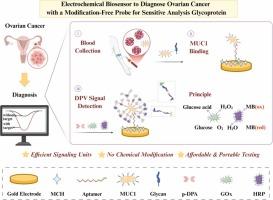以MUC1为例分析卵巢癌糖蛋白的新方法
IF 3.7
1区 化学
Q1 CHEMISTRY, ANALYTICAL
引用次数: 0
摘要
糖蛋白在生物医学研究和临床检查中都需要灵敏的检测。虽然现有的策略利用糖基化位点进行识别或信号标记,但它们并没有充分利用糖蛋白作为天然信号放大平台的潜力。为了克服这一局限,本研究提出了一种高灵敏度、无修饰的电化学检测策略。它采用具有双硼酸基团的硼酸衍生物。通过硼酸-顺式-二醇特异性相互作用,衍生物通过共价聚合同时直接共固定靶糖蛋白和聚糖修饰的级联酶。这形成一个酶级联扩增网络,诱导亚甲基蓝(MB)氧化还原循环产生差分脉冲伏安(DPV)信号输出。构建的生物传感器以mucin 1 (MUC1)为模型靶点,检测限为116 fM,线性范围宽(0.2 pM-20 nM),满足临床糖蛋白定量要求。该方法也为临床血清样品MUC1检测提供了有希望的结果。总的来说,这项工作充分利用了糖蛋白上天然糖基化位点的内在潜力。创新的双硼酸“分子抓手”策略可实现高效和特定的信号放大,具有操作简单,成本效益和快速响应等优势。最终为开发通用糖蛋白检测平台提供了新的途径,在疾病诊断和生物学研究中具有重要的应用价值。本文章由计算机程序翻译,如有差异,请以英文原文为准。

A new approach to sensitively analyze glycoprotein with MUC1 as an example for the diagnosis of ovarian cancer
Glycoproteins require sensitive detection for both biomedical research and clinical examination. Although existing strategies exploit glycosylation sites for recognition or signal labeling, they have not taken full advantage of glycoproteins’ potential as natural signal amplification platforms. To overcome the limitation, this study proposes a highly sensitive and modification-free electrochemical detecting strategy. Which employs a boronate derivative featuring dual-boronic acid groups. Through boronic acid-cis-diol specific interactions, the derivative simultaneously and directly co-immobilizes target glycoproteins and glycan-modified cascade enzymes via covalent polymerization. This forms an enzyme cascade amplification network, inducing methylene blue (MB) redox cycling to generate a differential pulse voltammetry (DPV) signal output. Using mucin 1 (MUC1) as a model target, the constructed biosensor achieves a detection limit of 116 fM with a wide linear range (0.2 pM-20 nM), meeting clinical requirements for glycoprotein quantification. The method also delivers promising results for MUC1 detection in clinical serum samples. Collectively, this work fully leverages the intrinsic potential of natural glycosylation sites on glycoproteins. The innovative dual-boronic acid “molecular grasper” strategy enables efficient and specific signal amplification, offering advantages including operational simplicity, cost-effectiveness, and rapid response. Ultimately, it provides a novel pathway for developing universal glycoprotein detection platforms, demonstrating significant value for disease diagnosis and biological research applications.
求助全文
通过发布文献求助,成功后即可免费获取论文全文。
去求助
来源期刊

Sensors and Actuators B: Chemical
工程技术-电化学
CiteScore
14.60
自引率
11.90%
发文量
1776
审稿时长
3.2 months
期刊介绍:
Sensors & Actuators, B: Chemical is an international journal focused on the research and development of chemical transducers. It covers chemical sensors and biosensors, chemical actuators, and analytical microsystems. The journal is interdisciplinary, aiming to publish original works showcasing substantial advancements beyond the current state of the art in these fields, with practical applicability to solving meaningful analytical problems. Review articles are accepted by invitation from an Editor of the journal.
 求助内容:
求助内容: 应助结果提醒方式:
应助结果提醒方式:


